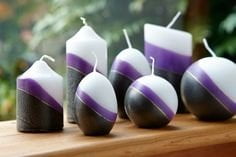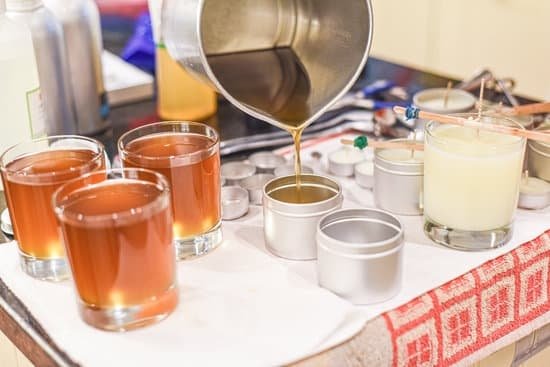Candle making is a captivating craft that has stood the test of time, captivating people with both its simplicity and artistic possibilities. But have you ever wondered what industry candle making falls under? In this article, we will dive into the fascinating world of candle making and explore its industry in depth.
Candle making is an age-old practice that dates back centuries. From ancient times to modern day, candles have played a significant role in various cultures and societies. The craft itself involves melting wax, adding fragrance or color, pouring it into molds or containers, and allowing it to solidify. But beyond this simple process lies a world of creativity and innovation.
The industry of candle making encompasses various aspects, including production, distribution, and sales. It is part of the broader consumer goods industry that includes everything from personal care products to home decor items. Candle makers range from small-scale artisans who handcraft their creations to large-scale manufacturers who produce candles on a mass scale for commercial purposes. With such diversity in production methods and market offerings, the candle making industry offers something for everyone interested in this art form.
In the following sections of this article, we will delve deeper into the world of candle making and its industry. We will explore topics such as the history of candle making, economic significance, market analysis, environmental impact, creative outlets offered by this industry, starting and running a successful candle company, as well as innovations and emerging technologies that shape its future outlook.
So let’s embark on this journey together to uncover the inner workings and wonders of the candle making industry.
What is Candle Making
Candle making is a centuries-old craft that involves creating candles by melting wax and adding fragrance, color, and other decorative elements. It is a process that requires skill, creativity, and attention to detail. This section will provide a brief overview of the craft of candle making, including the materials and techniques used.
Materials Used in Candle Making
The primary material used in candle making is wax, which can be derived from various sources such as beeswax, soybean oil, or paraffin. Beeswax is known for its high-quality and natural fragrance, while soy wax is popular among environmentally-conscious consumers due to its renewable and biodegradable nature. Paraffin wax is widely used due to its affordability and availability.
In addition to wax, candle makers also utilize wicks, which are typically made from braided cotton or hemp fibers. The wick serves to carry the flame and ensure a consistent burn throughout the life of the candle. Other materials commonly used in candle making include fragrances or essential oils for scenting the candles, dyes or pigments for coloration, and various additives such as stearic acid to enhance stability and burn time.
Techniques in Candle Making
Candle making involves several techniques depending on the desired outcome. The most basic technique is container or jar candle making, where melted wax is poured into a heat-resistant container with a pre-waxed wick inserted in the center. This method is popular among beginners as it requires minimal equipment and allows for easy customization.
Another common technique is pillar candle making, which involves molding hot wax around a central wick. This method allows for more intricate designs and shapes but requires specialized molds and equipment.
Dipped candles are made by repeatedly dipping a wick into molten wax until the desired thickness is achieved. This technique results in long taper candles often seen in traditional ceremonies or formal settings.
Candle making can also involve various decorative techniques such as embedding objects into the wax, creating marbled or layered effects, or adding textures through carving or embossing.
Overall, candle making is a versatile craft that offers endless possibilities for creativity and personalization. Whether it’s for ambiance, celebration, or relaxation, handmade candles have a unique charm that continues to capture the interest of enthusiasts worldwide.
A Glimpse into the History of Candle Making
The art of candle making has a rich and fascinating history that dates back thousands of years. From ancient civilizations to the modern day, candles have played an important role in various aspects of human life. This section will provide a glimpse into the history of candle making, tracing its origins and evolution over time.
Origins in Ancient Times
Candle making can be traced back to ancient civilizations such as the Egyptians and Romans. In these early times, candles were primarily made from animal fats such as tallow or beeswax. Tallow candles were widely used due to their affordability, while beeswax candles were considered a luxury item reserved for religious ceremonies or the wealthy.
The Middle Ages and Candle Technology Advancements
During the Middle Ages, candle making saw significant advancements with the introduction of new techniques and materials. The discovery of purification methods for beeswax allowed for cleaner-burning candles that emitted less smoke and odor. Additionally, the use of wicks made from cotton or hemp replaced earlier materials such as rushes or reeds, leading to more efficient burning.
Industrial Revolution and Modern Innovations
The Industrial Revolution brought about further advancements in candle making with the introduction of mechanized production methods and the use of stearin, a byproduct of animal fats, which improved candle quality. However, with the advent of electricity in the late 19th century, traditional candle use began to decline. Despite this shift, candle making persevered as an artisanal craft and experienced a resurgence in popularity during the late 20th century with increased interest in homemade and scented candles.
The Economic Significance
Candle making may be seen as a simple craft, but it actually carries significant economic importance. In this section, we will explore the various aspects that contribute to the industry of candle making.
First and foremost, let’s talk about the global market for candles. The demand for candles has been steadily growing over the years, with consumers using them for various purposes such as home decor, aromatherapy, and religious ceremonies.
According to recent market analysis reports, the global candle market size was valued at $3.45 billion in 2020 and is projected to reach $4.7 billion by 2028. This growth can be attributed to factors such as increasing awareness about the benefits of scented candles and rising disposable income among consumers.
Another significant aspect of the candle making industry is its contribution to employment and local economies. Candle manufacturing requires a range of skills including wax melting, fragrance blending, pouring techniques, packaging, and marketing. As a result, these businesses employ a diverse workforce that includes artisans, chemists, designers, salespeople, and more. Moreover, many small-scale candle makers operate their own shops or sell their products online, contributing to local economies and supporting entrepreneurship.
In addition to creating jobs and contributing to the economy, the candle making industry also serves as an essential supplier within various sectors. For instance, hotels often provide scented candles in their rooms to create a cozy ambiance for guests.
Similarly, event planners frequently incorporate decorative candles into weddings or other special occasions. Furthermore, there is a high demand for scented candles in spas and wellness centers due to their ability to create a calming atmosphere during massages or yoga sessions.
Overall, understanding the economic significance of the candle making industry is crucial in recognizing its impact on both local and global levels. From job creation and revenue generation to serving as a vital supplier across different industries – candle making plays an important role in our economy today.
- The global candle market size was valued at $3.45 billion in 2020.
- Projected to reach $4.7 billion by 2028.
- Rising disposable income and increasing awareness about the benefits of scented candles contribute to market growth.
- Candle making industry provides employment opportunities for various roles, including artisans, chemists, designers, and salespeople.
- Contributes to local economies and supports entrepreneurship through small-scale candle making businesses.
- Serves as a crucial supplier for industries such as hotels, event planning, and wellness centers.
Market Analysis
Understanding the market trends, demand, and growth potential of the candle making industry is crucial for both new and established businesses. In recent years, there has been a significant rise in the demand for candles due to their versatility and the various purposes they serve.
According to market research, the global candle market size was estimated to be worth $3.45 billion in 2020 and is projected to reach $6.64 billion by 2028, growing at a CAGR of 7.8% from 2021 to 2028.
One of the key factors driving the growth of the candle making industry is the increasing consumer preference for scented candles. Scented candles have gained immense popularity due to their ability to create a relaxing ambiance and evoke positive emotions. The fragrance segment accounted for the largest market share in 2020 and is expected to continue its dominance during the forecast period.
Another significant trend in the candle making industry is the rising demand for natural and eco-friendly candles. As consumers become more conscious about sustainability and environmental impact, there has been an increased focus on using natural ingredients such as soy wax or beeswax instead of paraffin wax, which is derived from petroleum. This shift towards eco-friendly options has not only attracted environmentally conscious consumers but has also created opportunities for small-scale producers who specialize in natural candles.
To capitalize on these trends and tap into new markets, innovation plays a crucial role in sustaining growth within the candle making industry. Companies are constantly introducing new products with unique fragrances and designs that cater to specific customer preferences. Additionally, leveraging e-commerce platforms and social media marketing has become essential in reaching a wider audience and expanding market share.
| Market Trends | Demand | Growth Potential |
|---|---|---|
| Rising demand for scented candles | Increasing consumer preference for natural and eco-friendly candles | Projected market size of $6.64 billion by 2028 with a CAGR of 7.8% |
| Innovation in fragrance options and designs | Growing popularity of candles as decorative items for home ambiance | New markets emerging from online sales and social media marketing |
The Role of Candle Making in the Wellness and Spa Industry
Candle making has become an integral part of the wellness and spa industry, offering a unique and soothing experience for consumers. With its calming ambiance and aromatic scents, candles have the ability to create a relaxing atmosphere that is highly valued in spa treatments and wellness practices.
The use of candles in spa therapies dates back centuries and has been a traditional practice in many cultures. The soft glow of candlelight combined with the gentle flickering flames can help to enhance meditation, yoga, or massage sessions by creating a sense of tranquility and serenity. Candles also provide an opportunity for clients to indulge in aromatherapy, as scented candles can release fragrances that promote relaxation, stress relief, or upliftment of mood.
In recent years, candle making has evolved to cater specifically to the wellness and spa industry. Many candle makers now focus on using natural ingredients, such as soy wax or beeswax, which are considered to be more conducive to a healthier environment. Essential oils are often used instead of synthetic fragrances to provide therapeutic benefits through aromatherapy. Additionally, eco-friendly packaging options have gained popularity among eco-conscious consumers.
The role of candle making in the wellness and spa industry extends beyond therapeutic treatments. Candles are often sold as retail products within spas and wellness centers, allowing customers to bring the tranquil experience home with them. This not only provides an additional revenue stream for businesses but also allows individuals to continue their self-care practices outside of professional settings.
Overall, candle making plays an important role in enhancing the overall experience offered by spas and wellness centers. By integrating candles into various treatments and providing high-quality products for purchase, businesses can create a serene environment that promotes relaxation and well-being for their clients.
Environmental Impact
Candles have long been a popular and beloved item in households around the world. However, as society becomes more conscious of environmental issues, it is important to examine the sustainability of candle making. This section will explore the environmental impact of candle making and whether it can be considered a sustainable industry.
One aspect to consider when evaluating the sustainability of candle making is the source of its primary ingredient: wax. Traditionally, candles were made from paraffin wax, which is derived from petroleum. The extraction and processing of petroleum have significant negative environmental impacts, such as air pollution and greenhouse gas emissions.
In recent years, there has been a shift towards using more sustainable options, such as soy wax or beeswax. Soy wax is produced from soybeans, which are a renewable resource that can be grown without harming the environment. Beeswax is another environmentally-friendly option since it is created by bees during honey production.
In addition to the type of wax used, other factors contribute to the sustainability of candle making practices. For example, the use of natural dyes versus synthetic ones can greatly reduce the ecological footprint of candles. Natural dyes are derived from plant-based sources and do not contain harmful chemicals that can harm human health or pollute waterways when washed away during production or use.
Another consideration is packaging materials. Using recyclable and biodegradable packaging options can reduce waste and minimize the impact on ecosystems.
Overall, while there are still areas for improvement, candle making has taken steps towards becoming a more sustainable industry. The use of alternative waxes and natural dyes shows promise in reducing environmental harm associated with traditional petroleum-based products.
Additionally, adopting eco-friendly packaging practices further enhances sustainability efforts within this industry. As consumers become more mindful about their choices and demand eco-conscious products, it is likely that candle makers will continue to prioritize sustainability in their practices in order to meet market demands and contribute to a greener future.
Candle Making as a Creative Outlet
Candle making is not only a practical craft but also a creative outlet that allows individuals to express their artistic side. The process of making candles involves selecting different types of waxes, fragrances, colors, and molds, giving individuals the freedom to experiment and create unique designs.
One aspect of candle making that showcases its artistic nature is the variety of shapes and sizes that candles can be made in. While traditional pillar and taper candles are still popular choices, there has been a rise in demand for more unique and decorative designs. Crafters now have the option to make container candles in various shapes, such as flowers or animals, or even experiment with sculpting their own candle figures.
The artistry in candle making is not limited to just the physical appearance of the candle. Fragrance plays a crucial role in creating an enjoyable experience for consumers. Candle makers have the opportunity to blend different scents together to create custom fragrances that can evoke specific moods or memories. Additionally, some candle makers go beyond traditional wax blends and incorporate natural materials like dried flowers, herbs, or even gemstones into their candles for added visual appeal.
| Key Elements | Examples |
|---|---|
| Shapes | Container candles shaped like animals |
| Fragrances | A blend of lavender and vanilla for relaxation |
| Decorative Materials | Candles adorned with dried rose petals |
Candle making serves as a creative outlet not only for individuals but also for artists who specialize in this craft. Some candle makers are known for their unique designs and hand-carved creations, transforming candles into intricate works of art. These artistic candles often become conversation pieces and decorative items in homes, emphasizing the artistic side of the candle making industry.
With the growing interest in handmade and personalized products, candle making provides a platform for individuals to unleash their creativity and produce one-of-a-kind pieces. Whether it is through experimenting with different colors, scents, or techniques, candle making offers endless possibilities for artistic expression within the industry.
By embracing the creative potential of candle making, both hobbyists and professional artisans contribute to the diversity of products available in the marketplace. Moreover, this aspect of the industry attracts consumers who appreciate unique and aesthetically pleasing candles that add a touch of artistry to their daily lives.
The Business of Candle Making
Starting and running a successful candle company requires careful planning, creativity, and business acumen. In this section, we will explore the key steps and considerations involved in launching your own candle-making business.
Research and Planning
Before diving into starting a candle company, it is crucial to conduct thorough research to understand the market demand, competition, and target audience. This research will help guide your decision-making process and ensure that you are creating products that align with consumer preferences. Additionally, creating a comprehensive business plan will provide a roadmap for success by outlining your goals, strategies, financial projections, and marketing plans.
Sourcing Materials and Equipment
To produce high-quality candles, it is essential to source the right materials and equipment. This includes selecting premium waxes (such as soy wax or beeswax), fragrance oils or essential oils for scenting the candles, wicks, dyes or colorants for adding visual appeal, containers or molds for shaping the candles, and packaging materials. It is important to research suppliers who offer high-quality materials at reasonable prices to maintain product quality while maximizing profitability.
Creating Unique Candle Designs
Differentiating your candle company from competitors is key to attracting customers. Invest time in developing unique candle designs that stand out in the market. This can be achieved through experimenting with different colors, shapes, sizes, textures, and finishes. Additionally, consider offering customizable options such as personalized labels or scents to cater to individual customer preferences.
Setting Up Production Space
Having a dedicated production space is essential for efficient operations. Consider factors such as ventilation (to maintain air quality while melting wax), storage space (for raw materials and finished products), safety precautions (fire extinguishers or sprinkler systems), and proper lighting. The setup should adhere to any local regulations regarding candle production.
Marketing and Distribution
To successfully sell your candles, it is important to develop an effective marketing strategy that encompasses both online and offline channels. This can include creating a visually appealing website or online store, utilizing social media platforms to showcase your products and engage with customers, participating in local craft fairs or farmers markets, and collaborating with influencers or bloggers for product reviews. Additionally, consider establishing partnerships with local retailers or spas to expand distribution channels.
Starting a candle company requires dedication, creativity, and a thorough understanding of the market. By carefully planning and implementing effective strategies, you can build a successful business that delights customers with beautifully crafted candles.
Future Outlook
In conclusion, the future outlook for the candle making industry is filled with potential and opportunities for growth. With advancements in technology and a growing consumer demand for unique and sustainable products, the industry is poised for innovation and creativity.
One area of focus for the future of candle making is the development of new materials and ingredients. As consumers become more conscious about their environmental impact, there is a rising demand for eco-friendly candles made from renewable resources.
This has led to the emergence of alternative wax options such as soy wax and beeswax, which are both natural, sustainable, and biodegradable. Additionally, there is an increased interest in using essential oils instead of synthetic fragrances to create healthier and more natural scents.
Another aspect that will shape the future of candle making is technology. Digital platforms have opened up new avenues for marketing and selling candles, allowing small businesses to reach a wider audience without the need for traditional brick-and-mortar stores. Social media platforms have become powerful tools for showcasing unique designs and engaging with customers directly.
Furthermore, advancements in automation and manufacturing technologies are streamlining production processes, reducing costs, and allowing businesses to scale up efficiently. From automated pouring machines to robotic packaging systems, these emerging technologies are revolutionizing how candles are made.
Overall, as the demand for candles continues to grow, so does the opportunity for innovation within the industry. By embracing sustainability practices, leveraging technology advancements, and staying attuned to changing consumer preferences, candle makers can stay ahead of trends and continue to thrive in this ever-evolving market. The future of the candle making industry holds countless possibilities; it’s up to passionate entrepreneurs and artisans to embrace them and create a brighter and more luminous future.
Frequently Asked Questions
What industry is the candle industry?
The candle industry is a segment of the consumer goods industry that focuses on the production, marketing, and distribution of candles. Candles have been used for various purposes throughout history, including illumination, religious rituals, decorative purposes, and aromatherapy. As such, the candle industry encompasses a diverse range of products and applications to cater to different consumer needs and preferences.
What category is candle business in?
The candle business falls under the broader category of home decor or home accessories. Candles are often considered as decorative items that can enhance the ambiance of a space with their soft glow and pleasant fragrance.
Therefore, the candle business is closely associated with other products related to interior design and home furnishings. From scented candles in luxurious containers to rustic handmade candles, there is a wide variety of offerings within this category to suit different styles and tastes.
What profession is candle making?
Candle making can be considered a craft or artistic profession. It involves creating candles by melting wax, adding color or scent if desired, pouring it into molds or containers, and allowing it to solidify. Candle makers require creativity and skill in designing unique candle shapes, patterns, colors, and fragrances that would appeal to customers.
Additionally, they need technical knowledge regarding different types of wax, wicks, dyes, fragrances, and safety measures during production to produce high-quality candles that burn evenly and safely. While some individuals may pursue candle making as a hobby or side gig, there are also professional candle makers who operate businesses dedicated solely to crafting candles for sale in various markets.

Welcome to my candle making blog! In this blog, I will be sharing my tips and tricks for making candles. I will also be sharing some of my favorite recipes.





